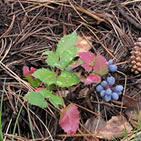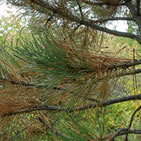Coming soon to a forest and grassland near you. Thank you for visiting the U.S. Forest Service's 2012 Fall Colors Web pages. We have some very useful tools to help plan your adventure to see fall trees and wildflowers this autumn. And there are fun things for the kids to do as well. As the Fall season progresses, check back regularly for new and exciting content!
Fall Foliage
Fall wildflowers
Cast your eyes across the forest floor this fall and discover the beauty of this season’s wildflowers. Learn More.
Fall colors science
The vivid autumn palette of red, orange, gold, and brown seen in many parts of the country is more science than art. Learn More.
Fall colors multimedia
U.S. Forest Service Chief Tom Tidwell invites the public to take advantage of fall colors by visiting a nearby forest or grassland. Other videos include our web cams in New Hampshire, North Carolina, West Virginia, Arkansas, and Montana. Learn More.
Get the kids moving outside
Another academic year is underway, and what better classroom than the great outdoors. We help you get started with coloring pages, ideas for activities and educational information about trees. Learn more.
Additional resources
Our world benefits from its many trees. Learn more.
Hotline 1-800-354-4595
Call the hotline then press the number of the area nearest you to get fall color updates:
- #1 for Montana, North Dakota and North Idaho
- #2 for Colorado, Kansas, Nebraska, South Dakota and eastern Wyoming
- #3 for Arizona and New Mexico
- #4 for portions of eastern California, Nevada, southern Idaho, Utah, western Wyoming
- #5 for California
- #6 for Oregon and Washington State
- #7 for Alaska
- #8 for Alabama, Arkansas, Florida, Georgia, Kentucky, Louisiana, Oklahoma, Mississippi, North Carolina, South Carolina, Tennessee, Texas, Virginia
- #9 for Illinois, Indiana, Maine, Michigan, Minnesota, Missouri, New York, Ohio, Pennsylvania, Vermont, West Virginia, Wisconsin
Fall Colors Stories
Read all stories
A coat of many colors cloaks autumn in the Bitterroot National Forest

Several plant species around Montana make their transition from summer to winter unique. This is highlighted in the Bitterroot National Forest including the Oregon-grape, a sub-shrub evergreen, the quaking aspen and the Rocky Mountain Maple among others.
Fall colors the muskeg on Alaska’s Tongass National Forest

Muskegs, a colloquial term for peat bogs, blanket 10 percent of the Tongass National Forest. Over the ages, muskegs formed as Sphagnum mosses, rushes and sedges grew and built up spongy carpets in these very wet, almost treeless areas.
Botanist shares fall’s native plant diversity on Black Hills National Forest

The Black Hills are a forested “island in the plains,” known for its pine-clad hills, which straddle the border of South Dakota and Wyoming. The northern Black Hills located south of Spearfish, S.D., are rich with native plant diversity and wildlife habitat that display an array of beautiful and subtle changes in the fall. Don’t forget to enjoy the scenic drives as well.
Planning a Trip?
- Recreation.gov is the place to make reservations for individual campsites, cabins and lookouts, group campsites, tours, picnic shelters, and wilderness permits on public lands.
- National Scenic Byways More than 9,000 miles of Scenic Byways pass through national forests and grasslands.
- Outdoor Safety is important when you travel on forests and grasslands.
- Find a Forest can help you find a forest near you.
- Learn to pack a survival pack if you're planning on spending a few days in the great outdoors.


